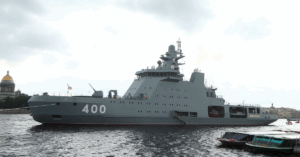
Bangladesh Seizes VLGC Captain Nikolas Months After LPG Transfer Fire
April 22, 2025
Chinese Cargo Ship Arrivals Drop Sharply At 2 Of America’s Busiest Ports
April 23, 2025

Russia’s new armed icebreaking patrol vessel Ivan Papanin has completed its initial round of Arctic sea trials. The vessel is expected to officially join the Northern Fleet later this summer.
It is built under Project 23550 by United Shipbuilding Corporation (USC). Ivan Papanin is the first of a new type of vessel specifically designed for Arctic military operations.
The vessel is one of two conventional icebreakers ordered for the Russian Navy to monitor and protect Arctic waters, particularly the Northern Sea Route, from Novaya Zemlya in the west to the Bering Strait near Alaska in the east.
Launched in 2019, Ivan Papanin began sea trials last year and recently finished its ice testing phase.
The ship’s construction started in April 2017. Although it was originally scheduled to enter service in 2023, several delays pushed its commissioning date to the summer of 2025.
A second ship of the same class, Nikolai Zubov, is set to follow in 2026.
The 8,500-tonne vessel is 114 meters long and 18 meters wide. It runs on diesel-electric propulsion and can generate up to 20,000 horsepower through two shaft lines.
The ship’s Arc7 ice class rating allows it to move through ice up to 1.7 meters (about 5.5 feet) thick.
This is the same ice classification used by Novatek’s LNG icebreaking carriers, enabling year-round navigation in many parts of the Arctic.
Its combination of icebreaking ability and combat readiness is what makes it stand out from others. The vessel is armed with a 76.2mm naval gun, several 12.7mm heavy machine guns, and portable air defense systems.
It has the capacity to carry eight Kalibr or Uran cruise and anti-ship missiles in modular, containerised launchers.
Russia’s new multi-purpose ice-class patrol ship Nikolay Zubov launched in St. Petersburg
The Nikolay Zubov, a Project 23550 combat icebreaker, is the second of its class to be built for the Russian Navy.
Construction of the ship began in November 2019 in the presence of… pic.twitter.com/Rbiwl65KLr
— Emeka Gift Official (@EmekaGift100) December 26, 2024
These would be placed on the rear deck, though they were not part of the recent trials. The design also allows for other types of container-based weapon systems depending on the mission.
The vessel includes dedicated facilities for a helicopter, a hovercraft, and two high-speed pursuit boats. It is also equipped for rescue missions, surveillance, and law enforcement duties.
A large fairlead at the stern suggests it could perform emergency towing operations when required.
Russia has two more vessels of similar design, Purga and Dzerzhinsky, under construction for the FSB’s border service.
These are being built at the Admiralty Shipyards in St. Petersburg and Vyborg Shipyard, with a construction schedule of around 4 to 5 years from launch to final commissioning.
Few countries operate military ships with both icebreaking capability and heavy armament. While Norway, Canada, and Denmark have ice-class patrol vessels for Arctic missions, none are configured with long-range missiles like the Papanin.
If armed with Kalibr cruise missiles, it would be the only icebreaker in the world able to strike targets hundreds of miles away.
The US, meanwhile, lacks any Arctic patrol vessels with icebreaking capabilities.
Its two current icebreakers, Polar Star and Healy, along with the upcoming Polar Security Cutter, are much heavier and designed for a wide range of Coast Guard responsibilities, including scientific research.
According to recent public information, the US Coast Guard is exploring ideas for an “Arctic Security Cutter,” which could potentially perform similar patrol duties with icebreaking features.
If developed, this new vessel could match some of the capabilities found in Russia’s Project 23550 class ships.
Source: Maritime Shipping News



